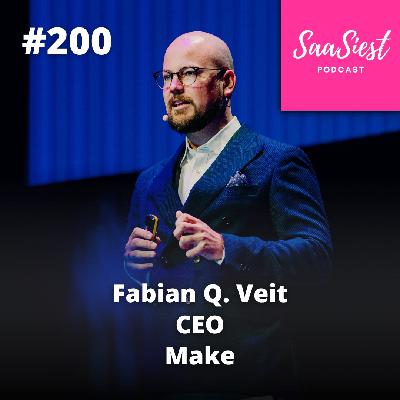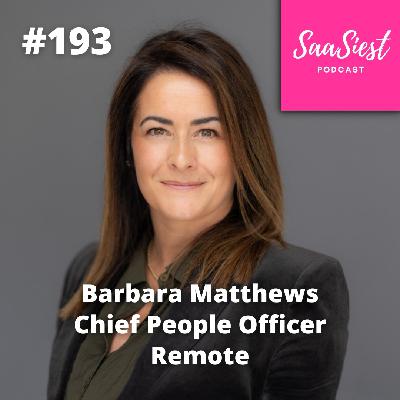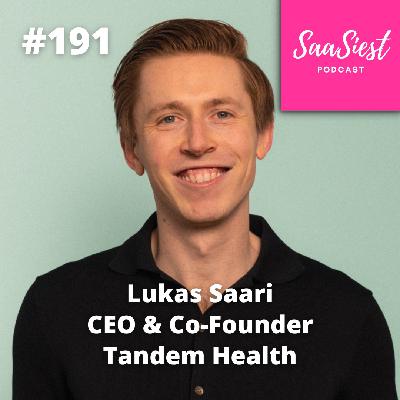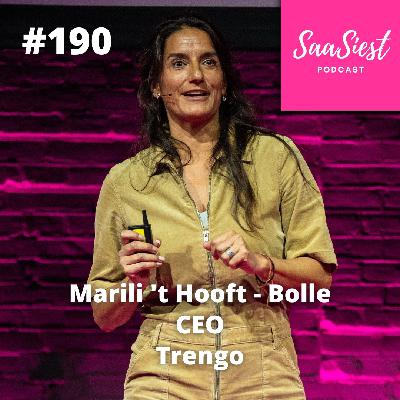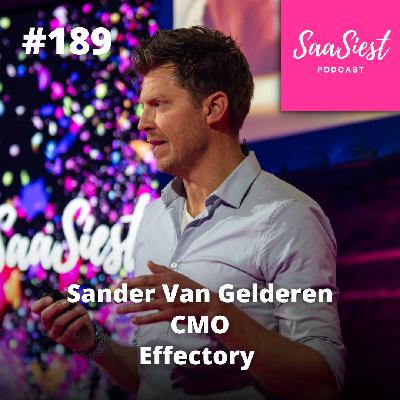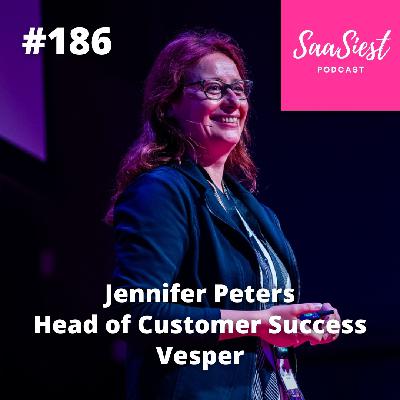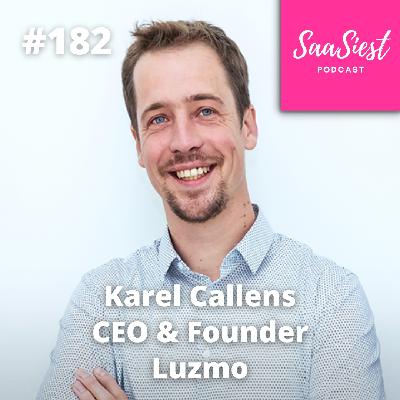Discover The SaaSiest Podcast
The SaaSiest Podcast

The SaaSiest Podcast
Author: Daniel Nackovski & Thomas Sjöberg
Subscribed: 16Played: 301Subscribe
Share
© Copyright 2020 All rights reserved.
Description
Do you want to know what the secret sauce is of the most successful SaaS companies? This show follows founders and leaders of the most prominent European SaaS companies on their way to global success. Learn from their GoTo-Market strategies, how they scale, build winning teams and great products. If you are a SaaS founder or leader looking for tips and tricks from the best in class founders and companies then this is a show for you. Direct, informal and to-the-point discussions with a great level of hands-on advice for the listeners. The show is brought to you by two experienced SaaS professionals, Daniel Nackovski, and Thomas Sjöberg, founders of SaaSiest !
200 Episodes
Reverse
In this episode, we sit down with Fabian Veit, CEO of Make.com, to talk about what it really takes to scale not just one but two hyperscale SaaS companies - first in a classic enterprise sales-led motion, and now in a PLG + AI/automation world.
Fabian shares how Make has 15x’d revenue and grown from ~50 to nearly 400 people, while racing past 100k+ paying customers and aiming for €100M+ ARR, and why that requires a fundamentally different mindset than selling multi-million euro deals into the Fortune 2000. He contrasts the “one deal can make your quarter” reality of enterprise sales with the high-volume, product-first, self-serve motion of Make, where thousands of users sign up every month and the product has to carry the weight.
We also dig into what it means to build in the middle of the AI & agentic wave when your platform is literally how people wire AI into their business processes. Fabian explains why most AI projects are actually 80–90% integrations & automation, where AI is the smart layer inside the flow, not the whole show, and how Make is evolving from classic “if-this-then-that” workflows into visual AI agents that power real operations.
You’ll hear Fabian talk about:
PLG vs Sales-Led: What changed when he went from 9–12 month, high-touch enterprise cycles at Celonis to Make’s “sign up free, upgrade yourself” engine.
Rebuilding While Scaling: Why everything is always breaking in hypergrowth, and how he decides what to fix for 5× future scale, not just today.
Brand & Positioning Pivots: The risky shift from Integromat to Make.com, losing SEO in the short term to win a much bigger global brand in the long term.
Culture at Hyperspeed: How they keep their values intact with hundreds of new hires through explicit values & operating principles, and a brutal honesty policy inspired by Radical Candor.
The AMA Channel: An internal Ask Me Anything Slack channel where anyone can ask leadership anything (even anonymously), and why Fabian believes answering every question publicly is non-negotiable for trust.
We wrap up with Fabian’s view on where we are in the AI hype cycle, why he compares this moment more to the industrial revolution than just another tech fad, and what kinds of human skills will matter even more in an AI-driven world.
In this episode, we’re joined by Pieter Boon, Co-founder at ImpactPilot, the customer success intelligence platform built for HubSpot. Pieter shares how he’s helping SaaS companies turn their CS orgs into true growth engines, measuring impact instead of activity through a framework called the Impact Driver Methodology.
Built on lessons from Google’s 10,000-person post-sales organization, this approach gives CS teams concrete ways to track success before renewal, using impact points tied to real customer outcomes like ROI proof, API adoption, or multi-year deals. It’s about replacing vague check-ins with measurable wins that move both customer and company forward.
We dive deep into how teams implement and operationalize the system, from designing the right impact drivers to setting incentives, avoiding false positives, and keeping customer value at the center. Pieter also reveals data from Impact Pilot users showing that customers with high impact scores are 7× more likely to renew or expand, and how that changes how you coach, measure, and reward CS teams.
Here are some of the key questions we address:
What is the Impact Driver Methodology, and how does it solve the lagging-indicator problem in CS?
How do you define and prioritize impact drivers that actually move the needle for customers?
How can CS leaders design incentive models that balance company outcomes with customer value?
What KPIs matter between onboarding and renewal, and how do you quantify “impact”?
How can you use impact scoring to predict churn and expansion before it happens?
What pitfalls to avoid, like rewarding “touches” instead of outcomes or overemphasizing feature use?
How can early-stage SaaS teams implement this framework (and even start with a simple spreadsheet)?
What’s next for CS as a function, and why Pieter believes it’s becoming the new growth engine for SaaS.
🎧 Tune in to hear how Pieter is redefining Customer Success for the revenue era where impact, not activity, drives retention, expansion, and long-term customer health.
In this episode, we’re joined by Jakob Lilholm, Co-founder & CEO at Formalize, the Danish-based compliance SaaS that went from a single-point whistleblowing tool to a multi-product GRC platform used by 8,000+ customers across ~80 countries. Jakob shares how his team timed EU regulatory tailwinds, built whistleblowing software, and then layered products on top, shifting from high-volume transactional sales to a focused, consultative motion for regulated industries.
Fresh off announcing a €30M Series B, Jakob walks through the internal rewiring it took: carving out an innovation pod with its own OKRs, resisting flattering false positives from the existing base, and proving platform demand with new-logo sales first, going from ~€100k ARR on the platform to >50% of company revenue in a year.
Here are some of the key questions we address:
When do you expand from a point solution to a platform? We discuss the timing model Formalize used (EU roadmap + S-curve “next wave” before the first peaks).
What’s the right ICP for a platform? Why did they end up narrowing their ICP and say “not yet” to others?
How do you avoid false positives when you already have thousands of customers? Jakob explains why he decided to validate platform fit with new logos first.
What org design supports a second act like this?
How do you shift GTM, pricing, and messaging? What is the process moving from low ACV sales to higher-ACV, consultative deals without breaking the engine?
Which metrics matter in the first year of a platform bet? How do you prove value creation, track conversion quality, and know when to re-inject the core team?
🎧 Tune in to hear how Jakob and team rewired a fast-growing SaaS from a single product to a multi-product platform play, aligning product, GTM, and finance while keeping the culture hungry enough to chase unicorn status by 2028.
In this episode, we’re joined by Rav Dhaliwal, recovering software exec turned early-stage VC at Crane. A longtime CS leader and board-level advisor, Rav breaks down how AI is reshaping Customer Success, from onboarding and telemetry-driven predictions to agentic workflows, while pushing CS to converge with account management and get far more revenue-centric.
We spoke with Rav about what AI should (and shouldn’t) automate, how to keep relationships authentic, and how leaders actually drive adoption, treating AI not as a tool drop but a behavioral change program.
Here are some of the key questions we address:
Will AI compress or redefine CS, and where does it create leverage vs. require human expertise?
What does the CS–Account Management convergence look like in practice (discovery, multi-threading, commercial acumen)?
Which AI use cases move the needle now: telemetry-based churn/upsell prediction, voice sentiment, and agentic next-best-action?
How do you avoid the “AI for efficiency only” trap and tie it to revenue, cost, and risk outcomes that customers actually buy?
What’s the playbook for AI adoption in GTM/CS? How do leaders run a change program (not a tool rollout) and measure progress?
Where are the authenticity risks and how do you keep the customer relationship human?
How far can we push AI-led onboarding and what’s the 90% automated vs. 10% bespoke split likely to be?
🎧 Tune in to hear Rav’s pragmatic take on CS in the age of AI: more signal, smarter workflows, tighter revenue alignment and leadership that treats AI as an operating change, not a shiny tool. Also, watch out for his new book coming out shortly on Founder-Led Sales!
In this episode, we’re joined by Inês Lourenco, VP of Growth at Usercentrics, the privacy-led MarTech company that is powering consent on 2M+ websites & apps across 200 countries for 600k customers.
Inês unpacks how she built a 50-person growth org of cross-functional pods (Monetization & Pricing, Acquisition & Virality, Activation, Partner Experience, CMS Integrations, and Retention) around a simple thesis: growth = product distribution. She details the early, scrappy phase with manual signal detection, nightly queries, and “product specialist” outreach - through to a scalable system that routes users to self-serve, low-touch, or high-touch paths based on predicted AOV, with a hard-earned lesson to start with activation before everything else.
We spoke with Inês about turning signals into revenue, structuring pods, and creating an operating cadence where every pod owns its metric such as ARPA growth, NRR/GRR, activation time, and virality share, while collaborating tightly with Product, Marketing, Sales, and CS.
Here are some of the key questions we address:
How do you define growth as product distribution and design pods that actually move revenue, not vanity metrics?
What signals predict AOV early, and how do you route users to self-serve vs. low/high-touch experiences accordingly?
Why did “product specialist” outreach outperform SDR-style messaging, and how do you structure those “baby-step” nudges?
If you’re starting from scratch, why begin with an Activation pod and what are the first experiments to run?
How do you set pod-level metrics (ARPA growth, activation time, virality share, NRR/GRR) and avoid cross-metric collateral damage?
What collaboration model keeps Growth aligned with Product, Marketing, Sales, and CS, and who should Growth report to?
When shouldn’t you build a growth team (and what to do instead if your top of funnel is small)?
How do you evolve from consent management to a privacy-led marketing platform, while staying profitable and fast?
🎧 Tune in to learn how Inês turned signals into a system, building a growth engine that’s rigorous, cross-functional, and activation-first, proving that modern growth isn’t a channel, it’s product distribution by design.
In this episode, we’re joined by Peter Sunna (ex-Contentful, Commercetools), now leading product at Kognic, an annotation platform that helps cars “see” via camera & LiDAR for ADAS and autonomous driving. Peter shares why he downplays traditional roadmaps in favor of a company-wide “How We Win” operating system, aligning teams on target segment, differentiation, and the strategic power to compound.
We dive into the automotive software shift, safety-critical AI, and how to build defensibility when AI keeps redefining what’s feasible, sometimes in months. Peter explains how to keep Sales, Product, Marketing, and CS selling and building the same thing so strategy drives the plan, not a feature laundry list.
Here are some of the key questions we address:
How do you replace feature roadmaps with a "How We Win" system that aligns every team and still tells customers what matters next?
What does differentiation look like in practice and which power are you compounding (process, network effects, brand, switching costs, etc.)?
When you’re early and have no moat, how do you use counter-positioning and when do you evolve to a more durable power?
Depth vs. breadth: should you go deeper on a few use cases or widen to adjacent ones, and how do you decide?
How do you sell a new workflow into enterprises (crossing the chasm) when existing org structures resist change?
With AI rapidly changing what’s feasible, how do you plan, defend your margins, and avoid being automated away?
🎧 Tune in to hear how Peter turns strategy into an everyday operating cadence proving that in B2B, roadmaps don’t win markets; clarity on how you win does.
In this episode, we’re joined by Frida Ahrenby, CMO at Rillion, the AP automation platform expanding aggressively in the US with a new Austin hub. Frida breaks down how she rebuilt marketing from zero to a lean, 10-person, high-output team, starting with a performance+ops backbone, overhauling content/SEO, and leaning hard into field marketing for CFO buyers, while keeping creativity human in an AI-accelerated org.
We spoke with Frida about sequencing the first hires, structuring around three pods (Demand Gen incl. Field, Brand/Content/Design, Product & Customer Marketing), and using AI to multiply output without outsourcing originality. She shares how to avoid silos and title inflation, decide what must be owned in-house to truly own the number, and what it really takes to crack the US market from a European base.
Here are some of the key questions we address:
How do you build a lean, unsiloed marketing org that still scales output (and keeps standards high) with AI in the mix?
What’s the exact hiring sequence from a blank slate: why start with performance/ops, then content/SEO, then expand demand?
Own it in-house or outsource? A simple rule for speed, agility, and true metric ownership and when agencies still help.
Which marketing roles will compress vs. which remain decisively human in the AI era?
What skills win now: how to hire for smart, analytical, creative demand gen, and deeply curious content that drives revenue?
🎧 Tune in to hear how Frida designed a tighter, faster marketing engine and why cracking the US is a marathon you run with data, creativity, and relentless focus, not headcount.
In this episode, we’re joined by Barbara Matthews, Chief People Officer at Remote, the Series C company with 1800 employees across 85 countries building an end-to-end global HR platform. Barbara shares how her team compressed a 6–8 week performance cycle into 48 hours using monthly manager “trend” nudges, lightweight pre-calibration, and AI-generated self/manager summaries, while scaling a transparent, high-performance culture in a fully async org.
We spoke with Barbara about designing performance to be continuous, objective, and fast, and how you can align leaders on what “good” vs. “great” looks like, avoid surprises for employees, and turn HR from a slow ritual into a real-time operating system.
Here are some of the key questions we address:
How do you build a high-performance culture (with transparency) across 85 countries without burning people out?
What does it take to shrink performance reviews to 48 hours, and what’s the exact sequence from self-assessments to calibrations, promos, and comp?
How do monthly nudges and a simple 5-point trend score improve alignment and reduce end-of-cycle thrash?
Where does AI add the most value in performance, and where should humans stay firmly in the loop?
What is pre-calibration, and how do you align managers on role expectations so ratings are fair and consistent?
How do you keep feedback truly continuous in an async environment - training managers, closing loops, and avoiding “annual surprise” syndrome?
When promotions aren’t available, what retention levers can be used to keep top talent engaged and growing?
🎧 Tune in to hear how Barbara re-engineered performance for speed and clarity, proving that modern people ops is a product you design, not a form you fill.
In this episode, we’re joined by Ruan Smit, SEO & Growth leader at Sendcloud, the leading shipping platform helping 30,000+ e-commerce brands connect carriers, print labels, and turn delivery into a competitive advantage. With a blend of technical SEO, AI know-how, and real-world growth experience across agencies, e-commerce, and SaaS, Ruan shares what actually moves the needle when AI is rewriting search.
We spoke with Ruan about how to gain visibility when AI Overviews and LLMs answer first, and how Sendcloud structures content, tech, and brand citations to appear where customers look—without losing focus on the pages that drive revenue.
Here are some of the key questions we address:
How do you prioritize GEO (Generative Engine Optimization) without sacrificing the SEO “money pages” that pay the bills?
What specific page structures (summaries, headings, FAQs, schema) increase your chances of appearing in Google’s AI Overview?
Where should teams invest to earn brand citations LLMs trust, and how do you do it without sounding salesy?
When does domain consolidation outperform country-by-country sites, and what are the must-do steps for clean migrations and 301s?
How do you track performance in a zero-click world—what proxies (impressions, BOFU outcomes, referrers) matter most?
What’s the practical workflow for “reverse-engineering” AI Overviews to refresh content that actually ranks and converts?
Are videos still worth it for discovery, and why is hosting on YouTube more important than ever for LLM sourcing?
🎧 Tune in to hear how Ruan blends solid SEO fundamentals with GEO tactics, proving that sustainable growth in the AI era comes from clear structure, smart measurement, and showing up helpfully wherever your buyers look.
In this episode, we’re joined by Lukas Saari, CEO and Co-Founder of Tandem Health, the AI-driven platform transforming how clinicians and healthcare teams work together to deliver better patient outcomes. By combining customer obsession with advanced automation, Tandem Health empowers providers to streamline workflows, reduce administrative burden, and keep the human touch at the center of care.
We spoke with Lukas about how AI is reshaping one of the most traditional industries and how Tandem Health has built trust with customers by deeply understanding their real-world pain points.
Here are some of the key questions we address:
How do you build trust with customers in industries where credibility and experience matter most?
Why should commercial and product teams include people who’ve actually lived their customers’ pain points?
How does every new onboarding experience fuel product innovation?
What role does deep customer understanding play in deciding where to take the product next?
Why must SaaS founders think in terms of “jobs to be done” rather than features, and how does that mindset unlock customer value?
🎧 Tune in to hear how Lukas combines customer empathy, sharp execution, and a forward-looking approach to AI adoption, proving that scaling in SaaS isn’t just about technology, but about truly understanding the people you serve.
In this episode, we’re joined by Marili 't Hooft-Bolle, CEO, Trengo, the AI-powered omnichannel customer engagement platform that unifies messaging across email, WhatsApp, live chat, social media, and more into a single shared inbox, helping teams automate repetitive tasks while preserving the human touch. Trusted by thousands of businesses worldwide, it empowers brands to deliver seamless, delightful customer interactions across every channel.
We spoke with Marili about how AI is changing the way they operate at Trengo - and how it has led to a future-proof mentality across the business in everything they do.
Here are some of the key questions we address:
How do you, as a CEO, drive AI adoption across the teams in their daily operations?
Why you may need to "update" your cultural and performance values to support the new AI era for operators?
What is the process to make sure new AI initiatives are focused on must-haves vs nice-to-haves?
How does she see the roles of product, engineering, and marketing need to adjust in this new era to fully leverage AI?
Why does she encourage everyone to be ready to dedicate some "learning money" on their journey to find the best AI leverage for their business?
🎧 Tune in to hear how Marili combines empathy, discipline, and sharp business acumen to guide her team through the reality of scaling in a rapidly evolving tech environment, proving that great companies are built not just on strategy, but on people who grow with intention.
In this episode, we’re joined by Sander van Gelderen, CMO at Effectory, an employee listening solution platform helping organizations measure and improve engagement, enablement, and productivity at scale, serving 700+ recurring customers across the Benelux, DACH, and now the Nordics.
We spoke with Sander about how Effectory transformed from a project-based consultancy into a recurring revenue SaaS business and how his team is reshaping their go-to-market motion through Account-Based Experience (ABX). The goal? Closing the gap between marketing and sales, reducing waste, and targeting only the accounts truly in-market.
Here are some of the key questions we address:
What is ABX and how does it differ from ABM in practice?
How do you unify marketing and sales targeting to remove friction?
What were the warning signs that the traditional MQL model wasn’t working?
How do you implement ABX without losing velocity or your team’s trust?
What process and tech changes are required to make ABX work?
How should marketing compensation evolve in an ABX world?
What are the real trade-offs and pitfalls no one talks about?
🎧 Tune in to hear how Sander and his team are aligning people, process, and technology, proving that better targeting isn’t just possible, it’s essential for sustainable growth.
In this episode, we’re joined by Charles Tenot, CEO of Lemlist - the bootstrapped sales engagement platform scaling past €36M ARR while staying lean, profitable, and fast-moving. Charles took the reins to help Lemlist break through a growth plateau, and under his leadership, the company has nearly tripled ARR and built a truly efficient, remote-first team of 110.
We spoke with Charles about what it really takes to build a high-performing executive team in today’s world of constant change and why being “close to the craft” might be the ultimate leadership advantage.
Here are some of the key questions we address:
What defines a truly efficient executive team, and why do most companies get it wrong?
Why is “disagree and commit” the wrong mindset at the C-level?
How can CEOs avoid building silos across product, marketing, and sales?
What red flags should you watch for when hiring experienced leaders?
How do you bring execs back to the craft without micromanaging?
Why does Charles prefer to hire all C-levels himself, and how does he do it?
🎧 Tune in to hear how Charles is reshaping SaaS leadership at Lemlist, proving you can scale fast without breaking what made you great to begin with.
In this episode, we’re joined by Ronni Zehavi, Co-Founder and CEO of HiBob—one of the fastest-growing HR tech platforms on the planet. With nearly 5,000 customers across the globe, HiBob is redefining HR through its modular, AI-powered platform “Bob,” built for modern, multinational, midsize businesses.
We spoke with Ronni about what it really takes to build a high-growth SaaS business that's not just growing fast—but growing right. From IPO readiness and leadership transitions to why putting people first is still your strongest moat in the AI era, Ronni shares the inside story of HiBob's 10-year journey to becoming a category leader.
Here are some of the key questions we address:
What’s the real reason HiBob is preparing for an IPO—and why now?
What are the internal changes a company must make to be IPO-ready? (Think finance ops, governance, reporting, culture)
How do you lead a company through different stages of scale without burning out—or stalling?
Why are line managers the true AI-era heroes inside organizations?
What’s the biggest mistake CEOs make on the path from $50M to $250M ARR?
What does “people-first” actually mean in practice—and how does it translate to business growth?
How is HiBob using AI internally, and how are they helping customers do the same?
What should you know about secondary events, long-term vision, and building a sustainable culture?
🎧 Tune in to hear how Ronni and his team are scaling HiBob into a global category leader—without compromising on values, velocity, or vision.
In this episode, we’re joined by Jennifer Peters, Head of Customer Success at Vesper, the commodity data platform working to bring transparency to the global commodity marketplace. Vesper provides market data, benchmarks, and forecasting to allow you to make confident decisions in volatile food markets.
We spoke with Jennifer about what it really means to design and implement an effective customer journey, and why managing a customer portfolio doesn’t automatically mean you’re managing that journey well.
Here are some of the key questions we address:
What’s the difference between managing customer portfolios and managing the full customer journey?
Where does the customer journey actually begin, and why is that moment so often misunderstood?
How do you make your onboarding flow keep pace with a fast-evolving product?
Why is launching a new feature once never enough?
What kind of adoption and usage metrics should CS teams monitor to prevent churn?
How do you operationalize customer success playbooks so they trigger action, not just insight?
What’s the role of CS in ensuring goals set during the sales cycle don’t disappear after onboarding?
How do you keep stakeholders across sales, marketing, and product aligned on the journey you're all supporting?
Tune in to hear how Jennifer and her team are building a proactive customer success engine at Vesper - and what any SaaS org can learn about keeping customers engaged, growing, and renewing long after the contract is signed.
In this episode, we’re joined by Emelie Linheden, VP of Marketing at Younium, a Subscription Management tool that helps B2B SaaS companies in Europe and North America streamline subscription management, invoicing and billing, financial reporting, and data insights.
We talked with Emelie about how Younium's event strategy has fueled their growth, and specifically how you make the most out of your investment in external events.
Here are some of the key questions we address:
- What are the most important criteria you use when deciding which external events to sponsor?
- What are the key things a team needs to do in the 4-6 weeks leading up to an event?
- How do you build a pre-event outreach strategy to ensure you're not just showing up cold?
- What’s your approach to lead capture, note-taking, and team coordination on-site?
- Who “owns” post-event results and how do you ensure accountability?
- What’s your timeline and process for post-event follow-up?
- How do you turn an event into a broader campaign that lasts beyond the week of the show?
- What KPIs do you track to evaluate event success—and how early do you define them?
Tune in to learn from Emelie how you also can make the most out of your event budget and plan, to ultimately drive real business value for your organization.
In this episode, we’re joined by Karolina Wrońska-Boukhalfa, Director of Customer Success, Dixa, the Value Experience Customer Service Platform empowering companies to deliver effortless, personalized experiences that drive customer loyalty. Trusted by leading consumer brands of the world, Dixa supports over 30 million conversations annually.
We talk to Karolina about how they go about segmenting customers, and specifically how to interact with each segment to drive real business value when you have a big pool of customers, and at times with very different characteristics.
Here are some of the key questions we address:
- How do you personally decide what dimensions to segment on — revenue, usage, potential, lifecycle stage? Can you walk us through a real segmentation model you’ve used that worked well?
- Once you’ve segmented your customer base, how do you make that segmentation actionable across the team? Any tips for operationalizing it across CS, Sales, and Product?
- Have you ever had to rework your segmentation model because it wasn’t driving the outcomes you wanted? What triggered the change, and what did you learn?
- In lower-revenue or long-tail segments, how do you ensure customers still feel seen and supported without scaling your CS costs?
- For a CS leader who’s never done structured segmentation before, or for the ones that need to revisit this exercise, what would be your first three steps to get started?
Tune in to learn how Karolina and her team are making sure that every customer is getting the attention they deserve and need to not just stick around but also to expand their commitment to Dixa.
In this episode, we’re joined by Søren Schønnemann, CEO, Factbird, the SaaS provider that helps manufacturers maximize their performance through manufacturing intelligence from Operator to Process Engineer to Plant Manager,
We talk to Søren about the hiring strategy and organizational evolution that he's taken the company on to support their rapid growth, from 8 to 90 people while going from startup to breaking 10m Euro in ARR in less than 4 years.
Here are some of the key questions we address:
- Why was his first 2 hires a Talent Aqcuistion specialist and a Sales Ops way before they had a commerial and GTM team in place?
- How has his hiring philosphy evolved as the company needs evolved?
- How do you balance the need for personal growth of staff vs the need of organization growth?
- What have been some of the most tricky challenges through this growth spurt and how did they handle them?
- Which are his biggest lessons learned from growing the organization at this pace, and what would he do differently next time?
Tune in to learn how Søren and his team have supported the need of the organization with a unique look at who to hire at what point in time, spoiler alert it is not sales people to start with, to get to the 10m Euro mark.
In this episode, we’re joined by Karel Callens, CEO & Founder, Luzmo, an embedded analytics platform, purpose-built for SaaS companies. They bring complex data to life with beautiful, easy-to-use dashboards, embedded seamlessly in any SaaS or web platform and are doing serving many well known customers across Europe and US.
We explore with Karel the concept of stacking S-curves on top of each other, making sure to always make the most of opportunities ahead and support an upward trajectory, even when that means pivoting, changing ICPs and more to make sure to fuel future growth!
Here are some of the key questions we address:
- How do you know it’s time to evolve or expand your ICP?
- What’s the actual process you use when making that kind of pivot or expansion?
- When you make a move to a new ICP, what happens to the existing one?
- What impact does this kind of ICP shift have on the org structurally and culturally?
- How do you align Sales, Marketing, Product, and CS around what might feel like a moving target
- What have been your biggest missteps in making these transitions - and what did you learn from them?
- We talked about stacking S-curves”—how do you plan that kind of growth without losing focus or diluting execution?
Tune in to learn how Karel and his team have set up a process to future-proof their business and always be ready for the next thing, not just to follow but to lead and control their business destiny.
In this episode, we’re joined by Massimo Arrigoni, CEO, Beefree, a powerful design suite that lets you create no-code beautiful, high-performing emails that work with any marketing platform. Today the Beefree platform is embedded in over 1000 SaaS products powering the email component for some of the most well-known SaaS companies in the world.
We explore how an embedded and white label product strategy has fueled Beefree's growth and specifically what the learnings are from this journey.
Here are some of the key questions we address:
- What does it really take from a company to offer an embedded white-label product?
- How do you determine if a part of your product is a good candidate to be sold as an embeddable component?
- What are the key differences between a traditional SaaS GTM strategy and an embedded/white-label model?
- How do you price an embeddable SaaS component to reflect the value it provides without overcomplicating contracting?
- How do you mitigate the risks or limitations of not being a domain expert in the industries you're embedding into?
Tune in to learn how Massimo and Beefree have leveraged an embedded strategy to grow to 15m+ USD in ARR, 30% year on year growth with practically 0 churn and a happy customer base all over the world.


